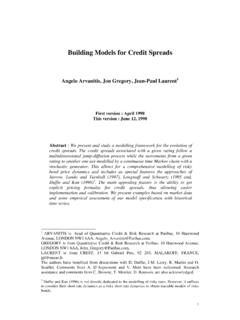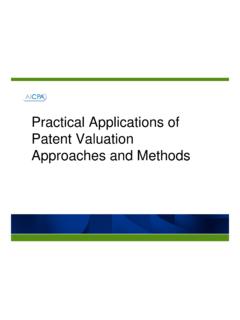Transcription of Calibration Methods of Hull-White Model
1 Calibration Methods of Hull-White ModelS ebastien Gurrieri1 , Masaki Nakabayashi1xandTony Wong1{1 Risk Management Department, Mizuho SecuritiesTokyoAbstractWe describe several strategies for the Calibration of one factor Hull-White Model with con-stant or time-dependent mean reversion and volatility parameters to the interest rate propose an efficient approximation formula for the swaption implied volatility which enablesus to estimate the mean reversion independently of the volatility. We give the closed-forms forexact pricing using explicit integrals of the Model parameters and propose parametric forms forthe mean reversion and volatility.}
2 We test their performance in terms of quality of tting andstability market changes, and show that excellent ts can be obtained without sufferingfrom instabilities. Furthermore, our Calibration Methods and parameter control techniques allowfor an elegant interpretation of market moves, which we illustrate with an in-depth analysis ofLehman crisis in the fall of 2008. email: Introduction22 Model Dynamics and Closed Dynamics .. Closed Forms for Caplets and Swaptions .. An Approximation of the Swaption Implied Volatility.
3 Parameter Speci cations .. 73 Calibration Relations Market/ Model parameters .. Optimizing on the Mean Reversion or not .. Bootstrap vs. Overall Calibration .. Calibration to Swaptions .. Method 1 .. Method 2 .. Method 3 .. 144 Numerical Performance of SMM approximation .. Choice of Instruments .. Co-terminal 20Y .. Conclusion .. Co-terminals 10Y and 20Y .. Constantaand .. Constantaand Time-Dependent (t) .. Time-Dependenta(t) and (t).
4 Conclusion .. All Instruments .. Conclusion .. Model and Market Evolution: analysis at Lehman Crisis .. Bermudan Swaptions .. 315 Conclusion33A Integrals34B Simulated Annealing36C Other Numerical SMM vs. Jamshidian Method .. Other JPY Calibration results .. Other currencies: USD .. Other currencies: EUR .. 4111 IntroductionMarket models, pioneered by [2], [9], have recently emerged as a market standard for the pricingof exotic interest rate products. In these models, the dynamics of observable market rates, suchas Libor and swap rates, are directly speci ed.
5 They are appealing to market practitioners largelydue to the fact that they can be calibrated to market caplet and swaption volatilities as well as aninitial yield curve. In spite of their increasing popularity, market models have one serious accurate implementation can only be made through simulation, which is typically slow due tothe large number of state variables ( the discrete{tenored market rates) needed to be evolvedthrough time, and the complicated drift terms associated with the underlying stochastic differentialequations (SDEs).}
6 This can be a problem for path dependent payoffs which require a large numberof simulated paths in order to obtain sufficiently accurate price and risk gures. The problem can beeven more acute for products with an early exercise provision as simulation is not naturally suitedfor performing backward{in{time calculations needed to determine the optimal exercise contrast to market models, affine term structure models (ATSMs) attempt to Model theunobservable short rate, assumed to be an affine function of some latent factors.}}
7 ATSMs have afew appealing properties. First, they are analytically tractable. In particular, closed{form solu-tions for caps/ oors and efficient price approximation Methods for European swaptions are oftenavailable. Second, Monte Carlo implementation of ATSMs is relatively straightforward comparedto market models. In low dimensional cases, path{independent products with an early exerciseprovision can also be evaluated efficiently using lattice Methods . Third, under ATSMs, all kinds ofinterest rates ( forward Libor and swap rates with any expiry/maturity/payment dates) can becomputed readily from the short rate factors, whereas in market models interpolation and extrap-olation are often needed when the product dates do not align with the canonical Model dates.}}
8 Thecomputational efficiency offered by ATSMs explains why many banks still use these models for riskcalculation and other risk management purposes even after the introduction of the market main objective of this paper is to analyze in details the issues of Model Calibration andparameter control associated with a popular ATSM, known as one{factor hull white (HW1F) Model ([5], see [3] for a review). The HW1F Model , which is characterized by a mean reversion anda volatility parameter, has been and is still very popular among market practitioners because ofits parsimony and analytical tractability (thanks to the normality of the short rate).}
9 In spite of itspopularity, the existing studies on the Model Calibration , especially in the case of time-dependentparameters, are rather scarce. In [6] and [7], the authors have covered the basic procedures forcalibrating the HW1F Model utilizing tree Methods . However, there does remain several openissues related to its practical , it is frequently claimed that adopting time-dependent parameters for the HW1F modelcan introduce over{parameterization. Yet, numerical examples backing such a statement are rarein the existing literature.}
10 As a result, it is unclear in what contexts and to what extent sucha statement can be justi ed. This also raises the question of how one should choose the modelparameter con guration, given a particular application at hand. Another challenging issue is relatedto the Calibration , especially in cases where time-dependent parameters are used. Given a certainparameter con guration, a natural question arising is what strategy one should use in calibratingthe Model . For example, one may ask what parameter constraints should be put in place duringthe Calibration or if the Model has some separable property that can make the Calibration moreefficient.








